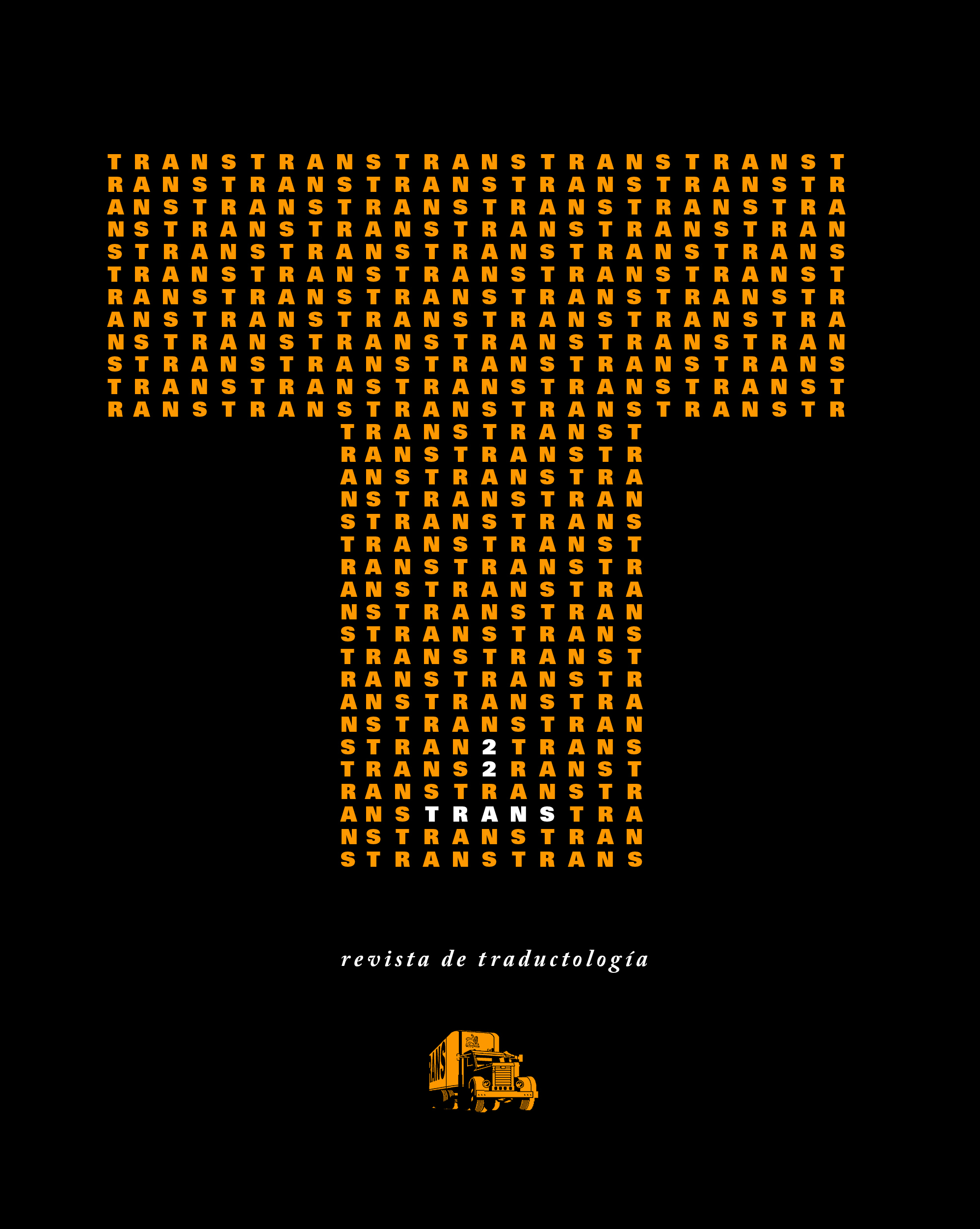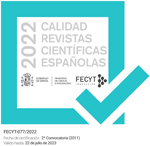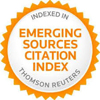De la traducción a la traducción audiovisual en el aprendizaje de lenguas extranjeras
DOI:
https://doi.org/10.24310/TRANS.2018.v0i22.3217Palabras clave:
traducción, traducción audiovisual, subtitulación, aprendizaje de idiomasResumen
El papel de la traducción en el aprendizaje de lenguas extranjeras
ha sido objeto de debate desde hace mucho tiempo. Especialmente con la llegada de enfoques más comunicativos, ha habido una tendencia a evitar cualquier tipo de traducción en la clase de idioma. Después de contextualizar la traducción en el aprendizaje de lenguas extranjeras dentro de los métodos y enfoques de enseñanza que se han desarrollado a lo largo de los años, este artículo propone la subtitulación como una tarea de traducción audiovisual que puede ser usada de manera efectiva en el aprendizaje de lenguas extranjeras en el marco de una perspectiva comunicativa.
Descargas
Métricas
Publicación Facts
Perfil de revisores N/D
Información adicional autores
Indexado: {$indexList}
-
Indexado en
- Sociedad Académica/Grupo
- N/D
- Editora:
- Universidad de Málaga
Citas
Atkinson, D. (1987). «The mother tongue in the classroom. a neglected resource?», ELT Journal. Vol.41(4). 241-247.
Austin, J. L. (1962). How to do things with words? Oxford. Clarendon Press.
Baños, R. & Sokoli, S. (2015). «Learning foreign languages with ClipFlair. Using captioning and revoicing activities to increase students’ motivation and engagement». In: Borthwick, K. & Corradini, E. & Dickens, A. (Eds.), 10 Years of the LLAS Elearning Symposium: Case Studies in Good Practice. Dublin and Voillans: Research-publishing.net. 203-213.
Bialystok, E. & Hakuta, K. (1994). In other words. The science and psychology of second-language acquisition. New York: Basic Books.
Bollettieri, R. M.; Di Giovanni, E; Rossato, L. (2014). «New challenges in audiovisual translation». In: Bollettieri Bosinelli, R. M., & Di Giovanni, E. & Rossato, L. (Eds.), inTRAlinea Special Issue: Across Screens Across Boundaries. From http://www.intralinea.org/specials/article/new_challenges_in_audiovisual_translation (last accessed 21st July 2017).
Borghetti, C. (2011). «Intercultural learning through subtitling: The cultural studies approach». In: Incalcaterra McLoughlin, L. & Biscio, M. & Ní Mhainnín, M. A. (Eds.), Audiovisual translation subtitles and subtitling. Theory and practice. Bern: Peter Lang. 111–137.
Borghetti, C. & Lertola, J. (2014). Interlingual subtitling for intercultural language education: a case study. Language and Intercultural Communication. Vol.14(4). 423-440.
Bravo, Conceição (2010). «Text on screen and text on air: A useful tool for foreign language teachers and learners». In: Díaz Cintas, J. & Matamala, A. & Neves, J. (Eds.), New Insights into Audiovisual Translation and Media Accessibility. Amsterdam: Rodopi. 269–284.
Brown, H. D. (2002). «English language teaching in the “Post-Method” era: Toward better diagnosis, treatment, and assessment». In: J. C. Richards (Ed.), Methodology in Language Teaching: An Anthology of Current Practice. Cambridge: Cambridge University Press. 9-18.
Brumfit, C. J. (1984). Communicative methodology in language teaching: The roles of fluency and accuracy. Cambridge: Cambridge University Press.
Carreres, Á. & Noriega-Sánchez, M. (2011). Translation in language teaching: insights from professional translator training. The Language Learning Journal. Vol.39(3). 281-297.
Chiaro, D. (2009). «Issues in audiovisual translation». In: J. Munday (Ed.), The Routledge Companion to Translation Studies. London: Routledge. 141-165.
Chomsky, N. (1959). A Review of B. F. Skinner’s verbal behavior. Language. Vol.35(1). 26-58.
Cook, G. (2007). A thing of the future: translation in language learning International Journal of Applied Linguistics. Vol.17(3). 396-401.
Cook, G. (2010). Translation in language teaching: An argument for reassessment. Oxford: Oxford University Press.
Cook, V. (2001). Using the first language in the classroom. Canadian Modern Language Review. Vol.57(3). 402-423.
Council of Europe (2001). Common European Framework for Languages: Learning, Teaching, Assessment. Cambridge: Cambridge University Press.
Deller, S., & Rinvolucri, M. (2002). Using the mother tongue: making the most of the learner’s language. London: Delta Publishing.
Díaz Cintas, J. (2008). «Introduction. The didactics of audiovisual translation». In: J. Díaz Cintas (Ed.), The Didactics of Audiovisual Translation. Amsterdam: John Benjamins. 1-18.
Dörnyei, Z. (2002). «The motivational basis of language learning tasks». In: P. Robinson (Ed.), Individual differences and instructed language learning. Amsterdam: John Benjamins. 137-158.
Ek, J. A. & Trim, J. L. M. (1990). Threshold 1990. Cambridge: Cambridge University Press.
Ellis, R. (2003). Task-based language learning and teaching. Oxford: Oxford University Press.
Ferreira Gaspar, N. (2009). «Translation as a fifth skill in EFL classes at secondary level». In: Witte, A. & Harden, T. & Ramos de Oliveira Harden, A. (Eds.), Translation in Second Language Learning and Teaching. Bern: Peter Lang. 173-179.
Fries, C. C. (1945). Teaching and learning english as a foreign language. Ann Arbor, MI: University of Michgan Press.
Gonzalez Davies, M. (2004). Multiple voices in the translation classroom. Amsterdam: John Benjamins.
Hymes, D. (1972). «On communicative competence». In: Pride, J. B. & Holmes, J. (Eds.), Sociolinguistics. London: Penguin. 269-293.
Incalcaterra McLoughlin, L. & Lertola, J. (2015). «Captioning and revoicing of clips in foreign language learning-Using ClipFlair for teaching Italian in online learning environments». In: C. Ramsey-Portolano (Ed.), The Future of Italian Teaching Newcastle upon Tyne: Cambridge Scholars Publishing. 55-69.
Incalcaterra McLoughlin, L. & Lertola, J. (2016). «Traduzione audiovisiva e consapevolezza pragmatica nella classe d’italiano avanzata». In: Troncarelli, D. & La Grassa, M. (Eds.), Orientarsi in rete. Didattica delle lingue e tecnologie digitali. Siena: Becarelli. 244-264.
Jespersen, O. (1904). How to teach a foreign language. London: George Allen and Unwin.
Johnson, K. (1982). Communicative Syllabus Design and Methodology. Oxford: Pergamon.
Kumaravadivelu, B. (1994). The Postmethod condition: (E)merging Strategies for Second/Foreign Language Teaching. TESOL Quarterly. Vol.28(1). 27-48.
Kumaravadivelu, B. (2001). Toward a Postmethod pedagogy. TESOL Quarterly. Vol.35(4). 537-560.
Lado, R. (1957). Linguistics across cultures. Applied linguistics for language teachers. Ann Arbor, Michigan: University of Michigan Press.
Larsen-Freeman, D. (2000). Techniques and principles in language teaching. Oxford: Oxford University Press.
Laviosa, S., & Cleverton, V. (2006). Learning by translating: A contrastive methodology for ESP learning and translation. Journal of the Slovene Association of LSO Teachers-Scripta Manent. Vol.2(1). 3-12.
Lertola, J. (2012). «The effect of subtitling task on vocabulary learning». In: Pym, A. & Orrego-Carmona, D. (Eds.), Translation research projects 4. Tarragona: Intercultural Studies Group. 61-70.
Lertola, J. (2015). «Subtitling in language teaching: Suggestions for language teachers». In: Gambier, Y. & Caimi, A. & Mariotti, C. (Eds.), Subtitles and Language Learning. Bern: Peter Lang. 245-267.
Lertola, J. (2016). «La sottotitolazione per apprendenti di italiano L2». In: A. Valentini (Ed.), L’input per l’acquisizione di L2: strutturazione, percezione, elaborazione. Firenze: Cesati editore. 153-162.
Lertola, J. & Mariotti, C. (2017). Reverse dubbing and subtitling: Raising Pragmatic awareness in Italian English as a second language (ESL) Learners. The Journal of Specialised Translation. Vol.28. 103-121.
Long, M. H. (1985). «A role for instruction in second language acquisition». In: Hyltenstam, K. & Pienemann, M. (Eds.), Modelling and assessing second language acquisition. Clevedon: Multilingual Matters. 77-99.
Lopriore, L. & Ceruti, M. A. (2015). «Subtitling and language awareness: A way and ways». In: Gambier, Y. & Caimi, A. & Mariotti, C. (Eds.), Subtitles and Language Learning. Bern: Peter Lang. 293-321.
Littlewood, W. (1981). Communicative language teaching. Cambridge: Cambridge University Press.
Malmkjaer, K. (Ed.) (1998). Translation and language teaching: language teaching and translation. Manchester, U.K.: St. Jerome Publishing.
Nunan, D. (2004). Task-based language teaching. A comprehensively revised edition of Designing tasks for the communicative classroom. Cambridge: Cambridge University Press.
Palmer, H. E. (1917). The scientific study and teaching of languages. London: George G. Harrap and Company.
Perego, E. (2005). La traduzione audiovisiva. Roma: Carocci.
Pérez González, L. (2009). «Audiovisual translation». In: Baker, M. & Saldanha, G. (Eds.), Routledge Encyclopedia of Translation Studies (2nd ed.). 13-20.
Richards, J. C. (2006). Communicative language teaching today. New York: Cambridge University Press.
Richards, J. C. & Rodgers, T. S. (2001) Approaches and methods in language teaching (2nd ed.). Cambridge: Cambridge University Press.
Schmidt, R. (1990). The role of consciousness in second language learning. Applied Linguistics. Vol.11. 129-158.
Searle, J. (1969). Speech acts: An essay in the philosophy of language. Cambridge: Cambridge University Press.
Skehan, P. (1998). A Cognitive approach to language learning. Oxford: University Press.
Sokoli, S. (2006). Learning via Subtitling (LvS). A tool for the creation of foreign language learning activities based on film subtitling. Paper presented at the Multidimensional translation: Audiovisual translation scenarios, Copenhagen. From http://www.sub2learn.ie/downloads/2006_sokoli_stravoula.pdf (last accessed 21st July 2017).
Sokoli, S. (2015). «Foreign language learning through interactive revoicing and captioning of clips». In: Gambier, Y. & Caimi, A. & Mariotti, C. (Eds.), Subtitles and Language Learning. Bern: Peter Lang. 127-148.
Sokoli, S., Zabalbeascoa, P., & Fountana, M. (2011). «Subtitling activities for foreign language learning: what learners and teachers think». In: Incalcaterra McLoughlin, L. & Biscio, M. & Ní Mhainnín, M. Á. (Eds.), Audiovisual Translation Subtitles and Subtitling. Theory and Practice. Bern: Peter Lang. 219-242.
Stern, H. H. (1992). Issues and options in language teaching. Oxford: Oxford University Press.
Stoddart, J. (2000). Teaching through translation. British Council Journal. Vol.11. 6-12.
Sweet, H. (1899). The Practical Study of Languages. London: Oxford University Press.
Talaván, N. (2010). «Subtitling as a task and subtitles as support: Pedagogical applications». In: Díaz Cintas, J. & Matamala, A. & J. Neves (Eds.), New Insights into Audiovisual Translation and Media Accessibility. Amsterdam: Rodopi. 285- 299.
Talaván, N. (2011). «A quasi-experimental research project on subtitling and foreign language acquisition». In: Incalcaterra McLoughlin, L. & Biscio, M. & Ní Mhainnín, M. A. (Eds.), Audiovisual translation subtitles and subtitling. Theory and practice. Bern: Peter Lang. 197-217.
Talaván, N. & Avila-Cabrera, J. (2015). «First insights into the combination of dubbing and subtitling as L2 didactic tools». In: Gambier, Y. & Caimi, A. & Mariotti, C. (Eds.), Subtitles and Language Learning. Bern: Peter Lang. 149-172.
Talaván, N. & Rodríguez-Arancón, P. (2014a). «The use of interlingual subtitling to improve listening comprehension skills in advanced EFL students». In: Garzelli, B. & Baldo, M. (Eds.), Subtitling and Intercultural Communication. European Languages and Beyond. Pisa: InterLinguistica, ETS. 273-288.
Talaván, Noa & Rodríguez-Arancón, P. (2014b). The use of reverse subtitling as an online collaborative language learning tool. The Interpreter and Translator Trainer. Vol.8(1). 84-101.
Talaván, N., Ibáñez, A., & Bárcena, E. (2017). Exploring collaborative reverse subtitling for the enhancement of written production activities in English as a second language. ReCALL. Vol.29(1). 39-58.
Trim, J. L. M. (2007). Modern languages in the Council of Europe, 1954–1997. Strasbourg, France: Council of Europe. From http://www.coe.int/t/dg4/linguistic/Source/TRIM_21janv2007_ EN.doc (last accessed 21st July 2017).
Williams, H., & Thorne, D. (2000). The value of teletext subtitling as a medium for language learning. System. Vol.28(2). 217-228.
Willis, J. (1996). «A flexible framework for task-based learning». In: Willis, J. & Willis, D. (Eds.), Challenge and Change in Language Teaching. Oxford: Macmilan Heinemann. 52-62.
Witte, A., Harden, T., & Ramos de Oliveira Harden, A. (Eds.). (2009). Translation in Second Language Learning and Teaching. Bern: Peter Lang.
Zabalbeascoa, P., Sokoli, S. & Torres, O. (2012). «CLIPFLAIR foreign language learning through interactive revoicing and captioning of clips. Lifelong Learning Programme - Key Activity 2. Languages, Multilateral Project. D2.1. Conceptual framework and pedagogical methodology». http://clipflair.net/wp-content/uploads/2014/06/D2.1ConceptualFramework.pdf (last accessed 21st July 2017).
Zojer, H. (2009). «The methodological potential of translation in second language acquisition: Re-evaluating translation as a teaching tool». In: Witte, A. & Harden, T. & Ramos de Oliveira Harden, A. (Eds.), Translation in Second Language Learning and Teaching. Bern: Peter Lang. 31-51.
Descargas
Publicado
Cómo citar
Número
Sección
Licencia
Todos los contenidos publicados en TRANS. Revista de Traductología están sujetos a la licencia Creative Commons Reconocimento-NoComercia-Compartirigual 4.0 cuyo texto completo puede consultar en <http://creativecommons.org/licenses/by-nc-sa/4.0>
Se pueden copiar, usar, difundir, transmitir y exponer públicamente, siempre que:
- Se cite la autoría y la fuente original de su publicación (revista, editorial y URL de la obra).
- No se usen para fines comerciales.
- Se mencione la existencia y especificaciones de esta licencia de uso.
- Compartir Igual — Si remezcla, transforma o construye sobre el material, debe distribuir sus contribuciones bajo la misma licencia que el original.
Los derechos de autor son de dos clases: morales y patrimoniales. Los derechos morales son prerrogativas perpetuas, irrenunciables, intransferibles, inalienables, inembargables e imprescriptibles. De acuerdo con la legislación de derechos de autor, TRANS. Revista de Traductología reconoce y respeta el derecho moral de los autores/as, así como la titularidad del derecho patrimonial, el cual será cedido a la Universidad de Málaga para su difusión en acceso abierto. Los derechos patrimoniales, se refieren a los beneficios que se obtienen por el uso o divulgación de las obras. TRANS. Revista de Traductología se publica en open access y queda autorizada en exclusiva para realizar u autorizar por cualquier medio el uso, distribución, divulgación, reproducción, adaptación, traducción o transformación de la obra.
Es responsabilidad de los autores/as obtener los permisos necesarios de las imágenes que están sujetas a derechos de autor.
Los autores/as cuyas contribuciones sean aceptadas para su publicación en esta revista conservarán el derecho no exclusivo de utilizar sus
contribuciones con fines académicos, de investigación y educativos, incluyendo el auto-archivo o depósito en repositorios de acceso abierto de cualquier tipo.













21.png)
